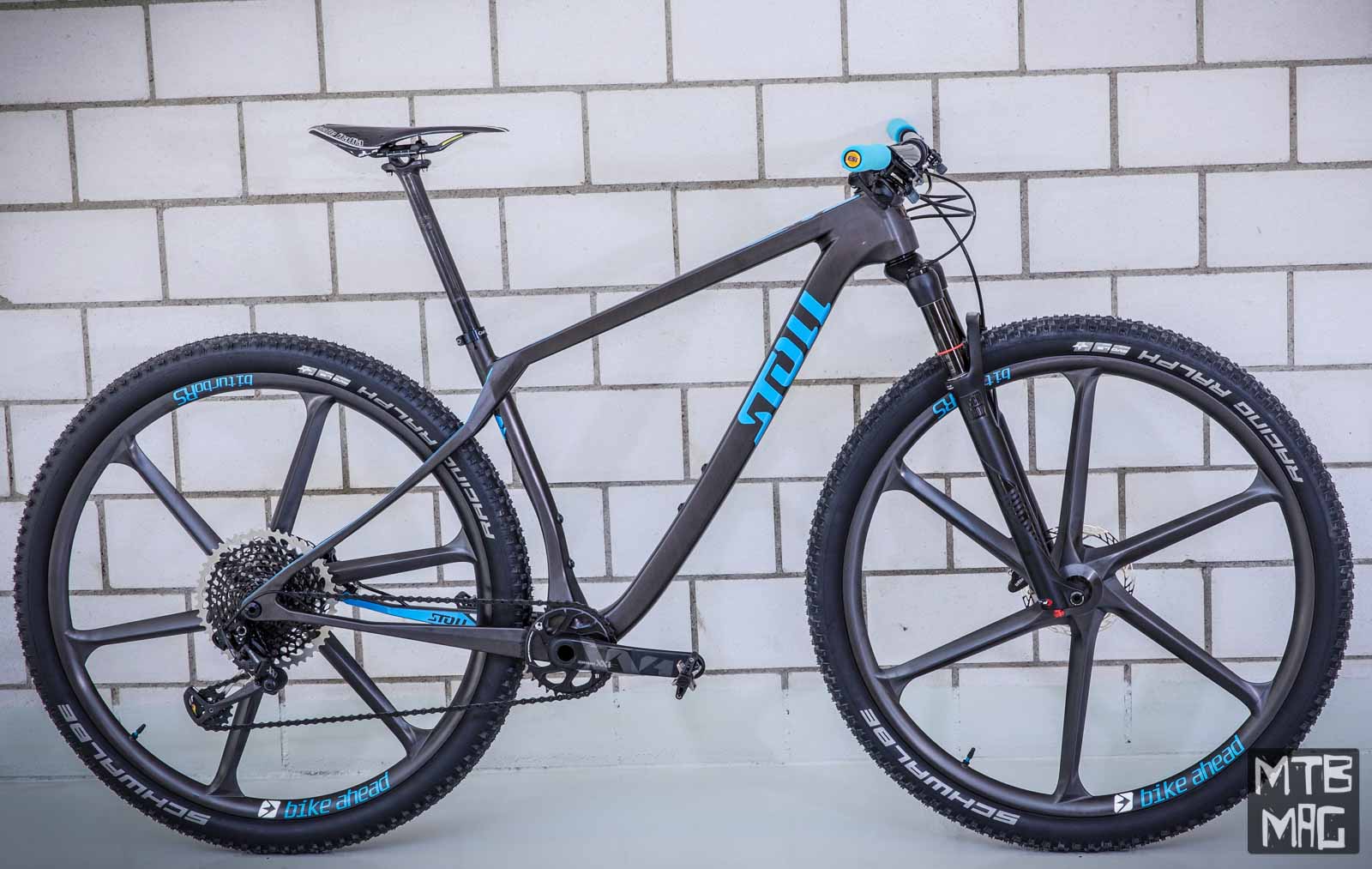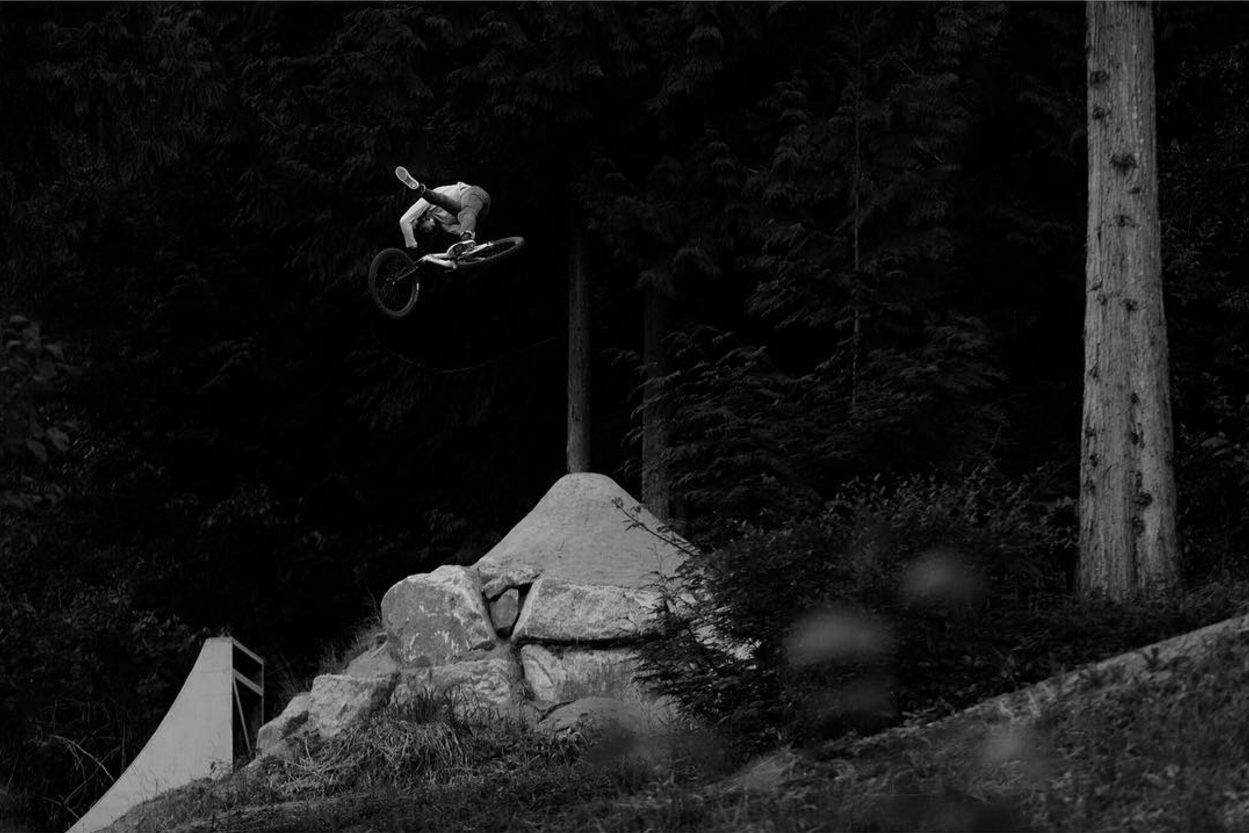Stoll is surely familiar to MTB-Mag readers since we’ve already reviewed the T1, a trail/all mountain full suspended bike which couldn’t really go unnoticed.
Stoll wants to amaze us once more, this time with the R1, an XC race and marathon hardtail which is something new in terms of building, geometry and, most of all, weight: the medium size weighs only 780g*. Stoll claims this is a record for a frame produced in series (even if a limited series).
(* weight measured without hardware such as the derailleur mount 18.5g, seatpost collar 9g and rear wheel axle 21.5g).
We had the privilege of being the first media to get our hands on and test the R1 on trail.
At first sight the bike seemed smooth and balanced, maintaining the Stoll character, that is sharp shapes and no coating on carbon parts with the exception of some decals. Always in search for the lightest solution.
Thomas Stoll is an engineer in his thirties who was a professional rider (he also won the Transalp Challenge); we believe he is a step ahead of other designers, and it can be seen analyzing his creations in detail: even the smallest part is the result of a complex designing process in which the racing experience can make the difference.
Stoll frames are made by BikeAhead, a German company specializing in the production of carbon frames and parts. Components crafting begins with prepeg carbon fibers cut with a specific plotter, placed in aluminum molds and then internally pressurized with “bladders”, finally they are put in autoclave. This process guarantees a stiffness/resistance/weight ratio which cannot be matched by other industrial procedures.
We asked Thomas how it was possible to reach such extreme weights without undermining the solidity and safety of the frame. His answer was that the frame is made in one single mold (very expensive) and not assembled. In other words, there are no joints bonded to tubes such as the rear triangle. Furthermore there is no coating on the outer part of the frame. The high quality of the materials and the experience of Christian Gemperlein of BikeAhead are responsible for the rest.
R1 Highlights
- Slack head angle. 68.8°, quite unusual for this type of bike.
- Single chainring frame only. Press fit bottom bracket. These two characteristics allow the bike to have a massive BB shell and therefore higher stiffness with efficient power and traction transfer to the rear wheel.
- The chain stays are tapered rearward and the seat stays are shaped to be flexible. The aim is to have good comfort and bump absorption values.
- Rear hub is Boost 148x12mm
- Internal rear brake mount
- Internal cable routing (rear brake included), cables are guided in order to avoid noises due to cables scratching the inside of the frame.
- Seat tube diameter 27.2
- Double bottle cage mount
Tested bike specs
- Group: Sram XX1 Eagle 10/50 34chainring
- FOX 32 STEP-CAST FACTORY Fork SERIES FLOAT SC 29, travel 100mm
- Wheels: DUKE carbon rims, 24 inner channel, 32 spokes, DT hubs, set weight 1350g.
- Tires: Schwalbe Racing Ralph rear. Rocket Ron front. Both 2.25 tubeless
- Brakes XTR M9000 Race, 160mm Ice-tech discs
- 27.2 BikeAhead carbon seat post with NSA insert (No Slip Application) to avoid slipping without having to tighten the collar too much.
- Collar : Carbon Ti
- 740mm BikeAhead full carbon bar with NSA (No Slip Application)
- NewMan EVOLUTION SL 318.2 6° stem. Weight: approximately 80g.
- Seat: Selle Italia SLR Carbon
- Handlebar grips: silicon ESIgrip
- Pedals: Crank Brothers Candy 11
Weight of the tested bike: 7.7 kg M size (w/o pedals)
Three sizes available: S-M-L
Two different Carbon layouts: 780g for riders lighter than 85kg, 850g for heavier riders.
Geometry
On the trail
Thomas Stoll called us to test his last-born bike on the amazing Engadin trails. Once we set the pedals and the seat height (our rider is 5 foot 9 and the M size was perfect), we started a ride on different kinds of terrain and tracks.
Climbing
The Stoll was very good (it could not be otherwise), at first on a flowing track and then on steep, double and single track, with extraordinary climbing speed and pedaling efficiency. On such terrain the light weight is clearly a plus, but the most incredible thing is how the R1 can ride over every single obstacle in the way. Rocks, roots, water drainage trenches: no problems at all, the rear end flows well and doesn’t tend to buck you off the saddle.
Obviously you need to face those obstacles at a higher speed than with a full suspended bike, but in our opinion the flexible structure of the rear end helps a lot on this kind of terrain. On steeper ground the front end never seemed too light and leaning slightly forward was enough to load the front wheel, keeping good maneuverability also in tight turns. The rear traction was never an issue either sitting or sprinting (unless you load the front too much).
Downhill
With an XC bike on descents, when the speed is high, it is important to have a stiff front end in order to force the wheel on the right line, without having to correct the trajectory too often, but at the same time it must not be too nervous and twitchy. The R1 was excellent in this field: on technical trails it follows the chosen line with no under steering. You just need to be centered, or lean slightly rearward (when out of the saddle) and bend your arms a bit to overcome even the most technical sections. The 68.8 head angle was a clear advantage also when the track got steeper and harder with rocks, roots and drops. Another efficient component was the Fox 32 SC fork, very progressive with 100mm of travel.
The lack of a dropper post was definitely an issue, but soon there will be lighter models specific for XC bikes to fill the gap.
Sprint and acceleration
We thought it was worth it to write a separate paragraph since in this sector the R1 really impressed us! Sprint acceleration is incredible, the light weight of the bike and the Duke wheels play an important role for sure, but we also liked the bottom bracket stiffness a lot. The Stoll can transfer every bit of power from the pedals to the rear wheel with no loss of energy.
Conclusions
At cycling trade shows like Eurobike it is not unusual to see ultra light bikes showcased at the booths, but often these bikes are built just to catch the attention and not to be actually ridden. Such numbers are often gained thanks to unreliable or inadequate components, for example ridiculously narrow tires or forks with no hydraulic system inside.
The Stoll instead weights only 7.7kg and mounts worthy components that could easily handle the stress of the most technical XC World Cup or marathon trails. The only thing we would change (to take part to a technical race) would be to install the same Schwalbe tires but with the Snake Skin option to reduce the likelihood of punctures.
The Stoll R1 revealed to be a super light yet efficient and balanced hardtail, quite comfortable, with a modern geometry and extremely well finished. It’s a real rocket, but it’s the kind which is very easy to control.
The frame itself costs 4000 CHF (€ 3500) and the full bike comes at 7000CHF (€6.150). It is a high price but don’t forget the frame is hand made in Germany with top-end technology similar to the one used in the Formula One circuit (autoclave). Stoll offers also a service which no other brand could afford: the possibility to customize the bike according to the needs and desires of the client, type of components and more or less frame rigidity depending on the rider’s weight.
It is possible to test ride the R1 on request at the various test days organized by Stoll all year round, published on the website.
If you want to pre-order the full bike or the frame set clich here. For further information contact Thomas Stoll.


















